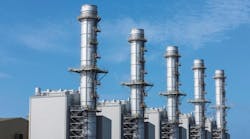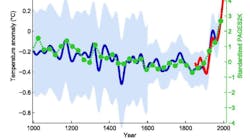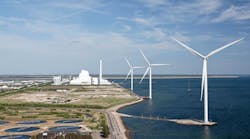This column has addressed various hydrogen production and utilization technologies several times over the past few years, which makes sense since the focus of Clark’s Remarks is sustainability, and hydrogen is a clean– zero-emission– fuel.
Like oxygen, hydrogen is plentiful, since they are both found in water. And when hydrogen is burned with oxygen, it has one of the highest energy density values per mass of any fuel. Compared to typical gasoline, for instance, hydrogen can yield 2.5-to-3 times the energy density. Of course, it does have its downside. Hydrogen is generally expensive to produce, and transporting it over long distances can be quite dangerous.
There are also concerns about the effects of offshore wind turbines on whales, fish, and birds. For instance, a National Oceanic and Atmospheric Administration (NOAA) study of New Jersey’s first offshore wind farms determined that it might “adversely affect” whales and other marine mammals. However, its construction, operation, and eventual dismantling would not seriously harm or kill them, another federal scientific agency concluded.
So, wind turbine operators will have to exercise extreme caution in siting their platforms in order to avoid sensitive areas. The better news for seabirds is that data from onshore wind farms indicates that wind turbines, if properly sited and operated, can avoid, minimize, and mitigate bird impacts, altogether.
- Download our new eBook celebrating 10 Years of Clark's Remarks. Click here.
Four years ago in this space, I wrote about a promising method for producing hydrogen from seawater. Most commercial hydrogen production using electrolysis requires relatively pure water, so the possibility of using seawater, rather than fresh water, to produce hydrogen was exciting.
Another option now being seriously explored is to produce the hydrogen at sea, using wind turbines to power the process. But it requires desalinated water. The advantages to powering hydrogen-producing electrolyzers with wind are obvious: economics and reduced greenhouse gas (GHG) emissions. Since offshore wind turbines offer higher wind yield, and the resultant higher load factors, transmission losses and costs are also reduced, further increasing overall efficiency.
In a recent article in the IEEE publication Spectrum, authors Matthias Mueller and Roland Dittmeyer, described the recent H2Mare, wind-to-hydrogen project. Mueller is the project's coordinator and a program manager for offshore hydrogen at Siemens Energy. Prof. Dittmeyer is director of the Institute for Micro Process Engineering at the Karlsruhe Institute of Technology (KIT). Led by Siemens Energy, the H2Mare effort leverages a consortium of 32 industrial (wind farm operators, OEMs, etc.) and academic participants, such as KIT.
The goal of the project is to demonstrate a solution that integrates the offshore wind turbine and an electrolyzer, allowing the hydrogen to be produced at the wind turbine. In that configuration, the hydrogen is piped to storage tanks or to ships.
In addition to H2Mare, the German Federal Ministry of Education and Research has funded two other significant demonstration projects. One concept places the wind turbines on floating platforms to generate AC power which is then converted to high voltage DC power and transmitted to onshore electrolyzers via submarine cables. Another similar configuration uses the high voltage DC on the floating platform and, like H2Mare, transfers the hydrogen via pipeline to storage or ships.
According to the IEA’s Global Hydrogen Review 2021, hydrogen demand was 90 metric tons in 2020, most of it being used for refining and industrial applications. Since almost all of it was produced from fossil fuels, the GHG emissions were nearly 900 metric tons of carbon dioxide equivalent (MTCO2e). And the IEA projected the global capacity of electrolyzers to reach more than 300 MW by mid-2021, up from 150 MW in 2018.
With projects such as H2Mare being developed, global hydrogen supply from electrolyzers could reach more than 8 metric tons by 2030. Unfortunately, that is also only about 10% of the amount required to stay on track to meet the IEA’s goal of net zero CO2 emissions by 2050.
Even so, kudos are still in order for all of the researchers involved here, and the government agencies funding that research. I just hope they don't forget to safeguard those whales and birds when it comes time to deploy these wind turbines.
##########
A contributor to HPAC Engineering since 2013 and a member of its editorial advisory board, the author is a principal at Sustainable Performance Solutions LLC, a south Florida-based engineering firm focusing on energy and sustainability. He can be reached at [email protected].









